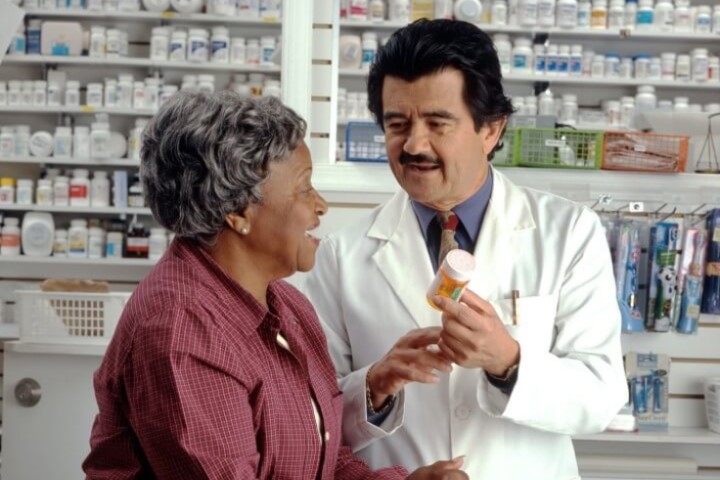INTRODUCTION
Middle age means different things to different people, men and women alike.
While youth is said to be the period when we are hopeless and every setback feels like the end of the world, the power of hoping through everything, the knowledge that the soul survives its adventures, is really great inspiration which comes with middle age.
Most men around the world find middle age to be the prime time of their life. It is also a period where he can find time to enjoy the beginning of a well-deserved reward for a life time of taking risks and working hard.
For the women they feel at the height of their abilities and most in control of their lives especially their sex lives with less pressure from men and fewer worries about getting pregnant.
Unfortunately, middle age is also a time when the body parts begin to wear out, thin out, grow limp or thicken none of which are relished by the aging male or female
Apart from the concern of getting fat, losing hair or keeping erection long enough for the men, the most important concern for both men and women within this age is the threat to life.
DEFINITION OF MIDDLE AGE
According to the Oxford English Dictionary middle age is the period between early adulthood and old age that is between 45 and 65
From the medical point of view middle age is viewed as the time of human life between youth and old age, usually reckoned as the years between 40 and 60. (Stedman’s medical dictionary)
SIGNS OF MIDDLE AGE
Signs of middle age includes but not limited to:
- Enjoying afternoon naps,
- Moaning when you bend over,
- Frustrated by modern technology,
- Choosing comfort over style when it comes to clothing,
- Spending more money on face creams /anti-aging products, Difficulty shading weight.
HEALTH CONCERNS COMMON TO MEN AND WOMEN
Chronic diseases, especially non-communicable diseases (NCDs), usually emerge in middle age after long exposure to an unhealthy lifestyle involving tobacco use, a lack of regular physical activity, and consumption of diets rich in highly saturated fats, sugars, and salt, typified by “fast foods.” This lifestyle results in higher levels of risk factors, such as hypertension, dyslipidemia, diabetes, and obesity that act independently and synergistically.
Krisela S, and Albertino D. 2006
OBESITY
Obesity is a body mass index (BMI)above 30. (WHO)The degree of body weight is usually expressed as BMI; this is the ratio of weight in kilograms to the square of height in meters. The BMI is used to classify a person’s body weight as underweight (BMI less than 18.5), normal weight (BMI 18.5–24.9), overweight (BMI 25–29.9), or obese (BMI greater than 30) (WHO 2000).In addition, it is customary to indicate the amount of abdominal fat mass. This can vary considerably among individuals who have the same BMI. Abdominal fat is reported by measuring the waist-to-hip circumference ratio. High abdominal fat mass is frequently referred to as central obesity. This form of obesity has been shown to have more morbidity than if the fat distribution is predominantly on the hips (WHO 2000). Obesity greatly increases the risk for conditions such as type 2 diabetes, hypertension, dyslipidemia, gall bladder disease, sleep apnea, osteoarthritis, and lower back pain. It has also been shown to be associated with some cancers. Solomon and Manson 1997; WHO 2000).
Despite its negative impact on health, an increased level of body fat is associated with beauty, prosperity, health, and prestige in some communities while Thinness is perceived to be a sign of ill health or poverty and is something to be feared and avoided, particularly in recent years, when it has been associated with AIDS
HYPERTENSION
- WHO’s Global status report on non-communicable diseases 2010 shows that hypertension is one of the most prevalent non-communicable conditions worldwide and it is responsible for an estimated 45% of deaths due to heart disease and 51% of deaths due to stroke globally.
- Medical guidelines define hypertension as a blood pressure higher than 140 over 90 millimeters of mercury (mmHg).
- High blood pressure is a major risk factor for heart attacks and strokes. It also contributes to renal disease and blindness. It is estimated that between 10 million and 20 million people in Sub-Saharan Africa have hypertension.(Cappuccio.et al.2000).
- However, hypertension in Sub-Saharan Africa is universally under diagnosed or inadequately treated, or both, with the result that extensive end-organ damage and premature death are often seen.
- Socioeconomic status and urbanization are good forecasters of hypertension as studies have shown that the lowest prevalence of hypertension occurred in the poorest and that as affluence increased, the prevalence increased. Studies carried out in Nigeria also revealed that hypertension was more common in urban than in rural settings as urbanization is associated with changing dietary patterns, less physical activity and a rise in socioeconomic status
CANCER
According to WHO two of the most common cancers affecting women are breast and cervical cancers
The latest global figures show that around half a million women die from cervical cancer and half a million from breast cancer each year The vast majority of these deaths occur in low and middle income countries where screening, prevention and treatment are almost non-existent, and where vaccination against human papilloma virus needs to take hold.
The lifetime risk for breast cancer among women increases with age – especially after age 50 – and only declines after he age of 80. lower fertility rates, increasing age of pregnancy and a decrease in the number of years of breastfeeding all contribute to a predicted rise in breast cancer in developing countries.
cervical cancer, providing girls with a new vaccine to prevent infection from the human papilloma virus (HPV), which causes cervical cancer, offers the possibility of eliminating the incidence of cervical cancer in the future. meanwhile, it is critical to provide existing cohorts of ageing women with pap smear screening or other low-cost prevention and screening technologies. Use of these techniques can dramatically reduce
For men the leading cancer is prostate cancer followed by lung cancer prostate cancer
Prostate cancer is one of the most common types of cancer in men. It usually grows slowly and initially remains confined to the prostate gland, where it may not cause serious harm needing minimal or no treatment, but some types are aggressive and can spread quickly.
OSTEOARTHRITIS/OSTHEOPOROSIS
Osteoarthritis is the degeneration of joint cartilage and the underlying bone, most common from middle age onward. (Stedman’s medical dictionary)
Osteoarthritis and Osteoporosis are associated with chronic pain, limited quality of life and disability.
The incidence of osteoarthritis is 20-fold in women as compared to 10-fold in men. Osteoporosis is three times more
common in women than in men, partly because women have a lower peak bone mass and partly because of the hormonal changes that occur at menopause and the effect of pregnancy which can alter calcium composition in a woman’s body in the absence of appropriate diet and/or administration of calcium supplements.
WHO 2007
HEALTH CONCERNS PECULIAR TO MEN
Erectile dysfunction (ED) is a medical term that describes the inability to achieve and or maintain an erect penis adequate for sexual function. This condition is one of the most common sexual problems for men and increases with age
There are three types of erections:
- Those caused by tactile stimulation,
- Those caused by mental stimulation (so called psychogenic erections – occur when a man has sexual thoughts), and
- Those that men experience while sleeping (so called nocturnal erections – healthy men of all ages have three or four each night with each erection lasting for 30 minutes). This classification can be important when the cause of erectile dysfunction is yet to be determined
MAIN CAUSES FOR ERECTILE DYSFUNCTION
ED can result from medical, physiological or psychological factors. The physiological causes of ED include three basic problems:
Not enough blood flows into the penis: Many conditions can reduce blood flow into the penis, examples include heart disease, diabetes and smoking.
The penis cannot store blood during an erection: A man with this problem, called venous leak or cavernosal dysfunction, cannot maintain an erection because blood does not remain trapped in the penis. This condition can occur to any man regardless of age.
Nerve signals from the brain or spinal cord do not reach the penis: Certain diseases, injury or surgery in the pelvic area can damage nerves in the penis.
PROSTATE HYPERPLASIA
Prostatic hyperplasia (BPH) is another name for enlarged prostate gland
Benign enlarged prostate gland is probably a normal part of the aging process in men, caused by changes in hormone balance and in cell growth. BPH occurs in almost all men as they age
SYMPTOMS
Frequent Urination
The most common symptom of BPH includes having to urinate more, often at night. The reason is that the enlarged prostate gland presses on the urethra, which carries urine out of the body. Because of this pressure, the bladder muscles have to work harder to excrete urine. The bladder eventually may start to contract even when only a small amount of urine is present, creating the urge to urinate more often.
Difficulty Urinating
Pressure on the urethra from the enlarged gland and the additional work required of the bladder muscles lead to other symptoms of BPH as well. These include taking longer to initiate a urine stream and urinating with a weaker flow than before. Urine may dribble, or you may feel that there is still urine inside the bladder even after you have finished urinating.
Inability to Urinate
If BPH completely blocks the urethra, inability to urinate may result. This can also happen as a result of infections or if the bladder muscles become excessively weak. The inability to urinate is a serious condition that can permanently damage the kidneys. If this comes on suddenly, go to a hospital emergency department. If you start to have symptoms of BPH, see your doctor right away in order to prevent worsening of the symptoms.
ROUTINE CHECK UPS
- Not all health problems have symptoms that will be noticed easily. Even a person who is the picture of health can be in a losing battle with cancer, diabetes, or other silent killers. The best way to detect these kinds of illnesses is by getting regular checkups it’s important you check your cholesterol, blood pressure, and blood sugar levels periodically so that you can catch those silent health destroyers early, when they can most easily be reversed or even cured.
- Self-breast examination, Mammogram, Pap smear and PSA should form part of your routine check schedule
EXERCISE
Exercise is vital to your health and quality of life. Whether you can make time in the morning or in the evening, schedule 30 minutes a day to get active. Walk, ride your bike, or try a new exercise class. If you have trouble with joint pain, take up swimming for a great non-impact workout. Be sure to add weight-bearing exercises to build muscle which boosts your metabolism and strengthens your bones. You’ll be amazed at how great you start to feel after just a few workouts and you might even lose a few kilograms.
REDUCE STRESS TO THE BEAREST MINIMUM
If you want to take a step toward healthy aging, you need to work on eliminating or reducing stress as much as possible. Excessive stress levels have been linked to heart disease, high blood pressure, and weakened immune function.
ALCOHOL/SMOKING
For years you’ve used alcohol to unwind after a tough day at work or to help take your cares away after a battle with your spouse. But while it may be able to help you initially relax, alcohol can lead to liver damage and also interfere with neurotransmitters in the brain that are needed for good mental health. As a result, alcohol can actually contribute to feelings of anxiety and depression, making stress harder to deal with.
Smoking decreases bone density, increases your risk for osteoporosis, compromises the immune system, increases the risk of developing age-related macular degeneration, cataract, and optic nerve damage, all of which can lead to blindness. It equally damages your airways and the small air sacs and is a risk factor for lung cancer.
So if you cannot stop these habits it completely ensures you reduce it to the barest minimum.
FOCUS MORE ON YOURSELF
The world will work without you. Use whatever extra time you have to focus on you – even if that means doing nothing at all!
IMPROVE ON YOUR SLEEP HABITS
Gone are the days when you could stay up all night and still make it to work with a glowing complexion. Fewer hours of sleep are linked to a greater risk of diabetes and other health problems, which become even more important as you age.
Lack of sleep reduces levels of melatonin, a hormone that may help protect against cancer. Please get enough rest.
CULTIVATE GOOD EATING HABITS
- Eat plenty of fruits and vegetables Eat more bananas
- Blood pressure tends to rise as we age. To combat this problem and lower stroke and heart attack risk, you should eat less sodium and more potassium.
- Focus on fiber
- Our grandparents may have been onto something with their ever-present packages of prunes: The fiber in the shriveled fruit helps the digestive tract run smoothly.
Overall, fiber intake is key for normal bowel function and may lower the risk of gastrointestinal inflammation. - Limit saturated fat
- Avoiding foods high in saturated fat
- Cut calories
- “As we get older, our metabolic rate slows down, so our calorie intake should drop accordingly,” says Rasmussen. “We don’t need as much to keep us moving.”
In general, people also tend to move less as they get older. - Cut out unhealthy carbs
- It is always good practice to limit foods high in sugar. But this rule may be particularly important as we age in order to keep a healthy weight, rest the pancreas (the insulin-pumping organ whose functioning goes awry in diabetes), and maximize the intake of healthy nutrients per calories consumed.
- Up your vitamin D
- Vitamin D is needed for your body to absorb and properly use calcium
- Get more calcium
- Calcium is good for your bones and is found in dairy products and other foods.
DENTAL CARE
Dental health is closely linked with overall health and gum disease which gets more common as one age has been associated with a higher risk of heart problems. So don’t skip those visits to the dentist.
DO NOT SETTLE FOR A BORING SEX LIFE
Our culture tends to sell the message that young equals sexy, but you don’t have to buy into it. You should have the confidence and freedom to dress and feel as sexy as you want to and feel as sexy as you want to, and explore your sexual needs as well.
“For many women, it’s the first time they are having sex for fun and enjoyment, not for a result (children).”
-Grufferman

Mrs. Ejiogu Charity
Occupational health practitioner. Member Institute of Occupational Safety and Health (IOSH)




